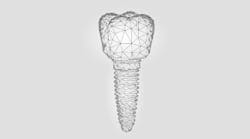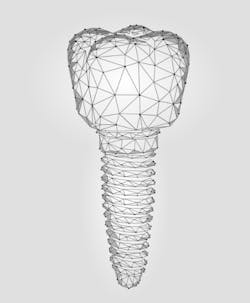'How long until I have a tooth, doctor?': Assessing dental implant stability noninvasively
Issue
Everyone who places dental implants is asked, “How long until I have a tooth, doctor?” Again, patients don’t care about the process—they just want results. And what is your answer?
I’d imagine, if you don’t have the right tools, your answer is often vague. In the past, I would glance at radiographs and see the bone-to-implant contact, or I would do the dreaded reverse-torque test. There is nothing worse than reverse-torque testing and discovering the reverse-torque value is a little too high, thus causing the implant to back out, and potentially having to start the entire process over.
Each implant case is different, and therefore each implant timeline is different, but there should never be a situation in which we move forward with impressions before we know unequivocally that the implant is fully integrated.
Solution
The Osstell IDx is a quick, noninvasive system used to determine implant stability and assess the process of osseointegration while guiding clinicians through the healing process. It provides the accurate, consistent, and objective information needed to make evidence-based decisions for consistent, successful implant outcomes. The Osstell IDx provides this feedback without compromising the integration process.
How it works
The system operates based on resonant frequency. Like a plucked guitar string, the implant will create a low frequency if loose and a higher frequency with better implant-to-bone integration when measured by the Osstell.
Unlike the reverse-torque test, the Osstell is a passive test, so there is no risk of damaging the implant. In a highly competitive implant market, dentists are pressured to deliver immediate results. Although no two patients are alike, this tool allows the clinician to deliver a consistent standard of care, based on data, and without potentially harming the patient through invasive testing or misleading imaging.
Investment
As a small business owner offering the service of dentistry, my focus is twofold. I must uphold the oath to deliver optimal care while also managing the constraints of proprietorship. The initial cost of the Ostell IDx is approximately $4,000, a relatively low investment in the world of dental equipment, and it should last for the majority of an implantologist’s career. The return is in the exponential cost savings. The machine validates itself by saving just one implant from short-term failure. In addition to the dentist’s time, replacing an implant on a slow-healing patient can potentially result in thousands in hard cost expenditures. The Osstell allows clinicians to proceed to temporization and restoration with empirical confidence.
The greatest return on investment cannot be seen or measured because it never appears. The Osstell measures patient response to bone remodeling and allows the dentist to assess healing and osseointegration before progressing to the next stage. This ounce of caution can prevent future issues such as angry patients, bad reviews, and lost time and money.
Conclusion
I have nothing to gain from promoting this product, but I have everything to lose if I misidentify the integration of implants in my practice. Implementing the Osstell IDx into my implant workflow has allowed me to restore implants with the highest degree of certainty that each implant has fully integrated. Additionally, the Osstell Connect online portal allows me to keep track of the integration progress throughout each case and relay that information to the patient easily. I highly recommend this product for the support it provides.
Editor's note: This article first appeared inthe Product Navigator.Click here to subscribe. Click here to learn how to submit an article.
Robert Stanley, PhD, DDS, is a mechanical engineer who left his career in telecommunications to pursue his passion for dentistry. He attended dental school at the University of North Carolina at Chapel Hill School of Dentistry, where he became a Smile Engineer. He brings his unique talents as a dentist and engineer to the clinic and the classroom. He is the founder of the Stanley Institute, a global leader in guided implant education.

